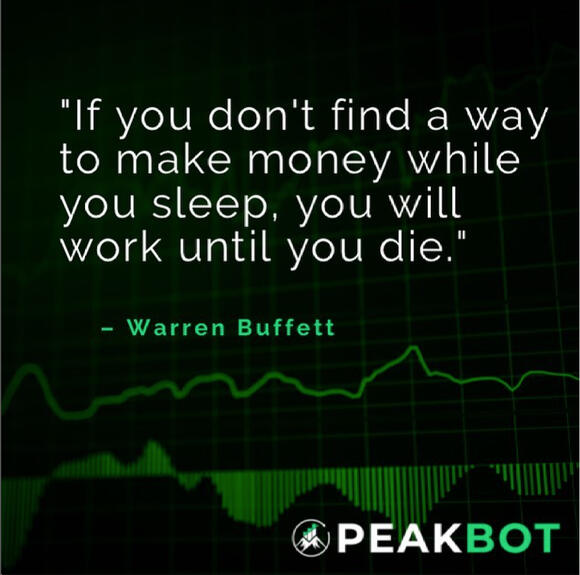
Startup Wants To Put A Stock Trader In Your Pocket, Aims To Become The Household Name For Algorithmic Trading
DISCLAIMER: During the interview for this story, the creators of PeakBot graciously offered to provide a discount to NewsBreak readers for trying out their services. The author has not received compensation for this article. While a promo code is included at the end of this story, it should not be considered promotional content but rather for informational purposes only. Previously published to NewsBreak.
Putting a stock trader in your pocket, one company aims to become the household name for algorithmic trading — compliant with known United States Securities and Exchange Commission (S.E.C.) regulations and available to a wide range of retail investors across the United States.
Regardless of trading experience, PeakBot works on behalf of its users to maximize gains while minimizing losses — a little robot crunching numbers in real-time, so you don’t have to spend countless hours planning how and when to close a position. It’s the Thumbelina of finance and the soon-to-be hero of every portfolio — of every smart trading strategy and smart traders everywhere.
The platform itself automates trades with rapid, unbiased responses to ongoing market conditions. And much like a professional trader, it elevates trading experiences by defending each portfolio, one trade at a time. Through automated, algorithmic trading, the risks of volatile markets are shielded from the downside, while PeakBot works overtime to capture the upside.
Problems Traders Face When We Don’t Use An Automated Bot
In just a few years, we’ll look back at a time when automated trading bots simply did not exist for the retail investor. We’ll realize how much time and emotion we’ve manually put into making well-thought trading strategies that didn’t pan out as we expected.
We’ll see hits and misses, wins and lost opportunities. And whether we HODL or “paper hand,” we’ll ultimately realize just how many dollars we left unwittingly on the table.
An effective strategy typically takes hours of research and monitoring of market data.
There are often way too many factors in deciding whether we should hold a position or to just let it fly. But at the same time, we don’t want to “execute a sell” too late or too early — because simply trading at the wrong time can mean missing out on a rally.
We let our fears, greed and emotions get the best of us rather than staying disciplined, trusting the data or sticking to a proven strategy. Because of this and other reasons, traders can really benefit by automating their trading strategies with a hands-off approach.
A Few Problems Resolved
Investopedia defines swing trading as “a style of trading that attempts to capture short- to medium-term gains in a stock (or any financial instrument) over a period of a few days to several weeks.”
But what about those who can’t idly sit by their computer? Those who work third shift and sleep during the day? Those who work hard labor and can’t pull out their phones whenever they please?
Many of these are, too, investors who lack the necessary time — the time to research, the time to trade and the time to assess the markets on an individual stock basis. Many of them work overtime and get very little sleep as it is. And still, they can’t always find a financial advisor or pay the high fees to have someone actively trade on their behalf.
Then, there are those traders who act on fear, greed or emotion. They fear missing out (FOMO). They ignore, or are ignorant to, key signals that could save them from painful trades. They’re quick to sell when the market experiences slight fluctuation, thinking “just a little bit longer” or “okay, it’s been in there long enough.” They exit too early, or stay in way longer than they should — or they’ve waited too long and got in when the price was too high.
In the past, we relied on selling the news and buying the rumor — some relied on insider trading, but look where that got them. Going into a new era means adopting new strategies that allow portfolios to grow overnight.
Sometimes, this means standing by brokerage apps to see what happens in the premarket and after hours. But most of the time, this will mean relying on tools and trackers to assess volatility while operating on your behalf. The whole idea behind PeakBot is to save the trader time and money while eliminating fear and greed — two of the most significant issues and mistakes that are made in the markets when emotions get in the way.
Markets can be devastating, so there are times we’ll inevitably lose and fall short of our highs. Unless you sell, you’re not really losing — but making smarter exits can mean making more over time. Sometimes take losses. We deduct those during tax season.
By using an automated bot, there’s no guarantee you’re not going to lose. There’s just a greater chance that you’re going to lose much less if you do. By re-entering the markets, you can buy into another stock or buy the same stock at a much lower price. Allowing bots to trade on your behalf means seeing greater profits over time.
A Method So Good, It Almost Feels Like Cheating
After 6 whole weeks of beta testing, the platform’s automated trading bot is now live across the country.
Initially, the company planned on launching in late September or early October. However, PeakBot officially opened shop on August 16, 2022, after seeing a sudden increase in demand for its automated trading bot. With a smooth launch, the team saw that a majority of beta testers were more than happy to convert to paying subscribers — the other 30% of users are still in their trial period.
And while some of these subscribers revealed themselves to be influencers within the world of investing and finance, including Kenneth Suna and Raylin Records — “Super Girl Investor,” others had no prior experience trading equities.
“We’re really bridging this divide,” states Ben Colabella, one of three co-founders at PeakBot.
“There’s a massive gap between new retail investors and the professional trader,” he continues. “We want to educate, automate and elevate our user base and have made those our three pillars throughout this project. We want to educate the new trader and to let them know that you don’t have to be an expert in the market to get involved. We also want to educate the active trader — while letting them know, we’re not asking them to change what they’re already doing, but instead, that this is a great tool to supplement their personal investing strategies.”
“As far as the algorithm goes, it’s very stable,” explains co-founder Dillon Del Rosso. “We’re delighted with the results. From our testers, we’ve gotten great testimonials, great feedback — and we’re very actively in touch with our community because we’re building this for them.”
For the time being, users can only access the “Momentum” trading bot — an algorithm that trades based on a momentum-based strategy, a familiar trading strategy for active users.
In a few more weeks, more bots will be available to PeakBot subscribers and stored within the cloud. One bot, in particular, is called “Gap ‘n’ Go,” and it uses an overnight gap trading strategy that allows users to take advantage of short rallies in the market and capitalize on the current volatility most companies are experiencing.
What Makes This Company Stand Out From Other Bots On The Market?
At the moment, very few bots were created, or are even operating, on American soil. They’re not compliant with the U.S. S.E.C. regulations or are restricted based on territory. Some aren’t accessible to the public and are only available to hedge funds and private users, who are charged outrageous premiums per use or subscription.
Bots that use their own brokerage are considered extremely risky. In addition, those operating outside of the United States may trade according to rules that are illegal in this country. There are also more protections for users using existing exchanges — and although there’s been a bit of noise that bot trading might not be ethical, PeakBot prides itself on transparency, fairness and risk mitigation.
Services like PeakBot that operate as add-ons within existing brokerage applications, however, are, in fact, compliant and can provide users with a greater level of customer service. The team is available in all three time zones and has established an ongoing competition to see who can help out their customers the fastest.
PeakBot can be accessed on any device, anywhere in the world, that has a solid internet connection.
A Priority On Transparency, Ethics And Protecting The Assets Of Users
The markets have been brutal since the onset of 2022. There’s been significant stock market volatility, including a devastating Q1 in which most businesses have not yet recovered.
Believe it or not, PeakBot’s creators have a strong sense of ethics when it comes to automated trading, as a decentralized hedge fund — putting professional algorithms into the hands of the retail investor.
While PeakBot executes on the upward and downward trend of technical indices, its founders believe that offering a broader window to pick and choose stocks will provide customers with a better understanding of potential catalysts they may face when trading on a consistent basis.
In fact, this is one company that offers a 90-day risk-free trial for every new subscriber. They’re also mitigating risks on behalf of their users. The company is super confident in its product and wants this to be reflected in the customer’s overall experience — especially the new trader with next to zero exposure to the markets.
PeakBot currently prohibits day trading and activities during the premarket or after the closing bell. Although trades can be executed before the closing bell at the end of each trading day, the company intentionally disallows trading during pre-market rallies and after-hour sell-offs to limit potential issues relating to liquidity and slippage that often occur within the market.
This is a new industry, but the creators of PeakBot certainly have done their due diligence when it comes to meeting laws, regulations and compliance-related parameters. This has also led to limiting how many shares can be traded on a daily basis. The trio believes in diversification and educating its investors on ways to better place their bets.
If everyone were using automated trading and using it at the same time, this could essentially become problematic. In fact, PeakBot has already taken into consideration measures that would ensure their bots won’t be a real issue in the future, especially in terms of driving a stock’s price in either direction.
Because some traders are more seasoned than others, PeakBot has implemented tiers based on subscription level. Users with a Tier-1 subscription can trade up to $500 per stock, while users in Tier-3 can trade up to $10,000. Capital allocation also limits vary by Bot.
Technical traders love volume and volatility. And the creators of PeakBot know this. Manual trades can still be executed within the brokerage app. Users are encouraged to keep their brokerage notifications on to ensure no opportunity is missed and that no trade is left behind.
Currently, every single algorithm is based on swing trading. PeakBot buys in at an optimal rate, so it’s not unusual that a single trade may see a 25% increase in a shorter-than-average timeframe. Bots will never buy and sell a stock on the same day, and most transactions are executed before mid-day.
“We don’t want our bots to contribute to market disruption. A lot of traders are now making a living by trading stocks,” explains Dillon Del Rosso. “We don’t want people entering and exiting positions to the point where order flow will be disrupted. We’ve put limits on what our investors can do, based on their trading style and technique.”
“Now if your bot made a purchase in the morning,” he continues, “and if by lunch, it’s up 25% — and you want to completely cash out — go for it. Execute ‘the sell’ manually. PeakBot does the hard part. We’re aiming to keep you from 75% of the downtrends and buying in on 75% of the uptrends.”
All of PeakBot’s algorithmic trading strategies are dependent on the use of technical indicators and will send “buy” and “sell” signals directly to your brokerage app. The bots will conduct technical analysis and execute trades on your behalf. Each strategy takes advantage of multiple technical indicators and places optimal bids based on the rising and falling of markets.
Traders can plug-and-play each bot on just about any stock, taking advantage of upswings and aborting risky downtrends before it’s too late.
How It All Works
First, users should subscribe to PeakBot and activate their service. They’ll visit the “Bot Shop” and select the bot that best aligns with their desired trading strategies. Once they hit “Automate,” they’ll indicate which stocks and exchange-traded funds (ETFs) to trade and the type of budget they’re comfortable spending.
While the company plans to integrate across several popular brokerages in the future, PeakBot works exclusively within the TD Ameritrade network.
During user testing and analysis (UTA), one co-founder admits to placing the same exact bid with two different brokerages. On 1 app, he’s down 62% year-to-date (YTD). Meanwhile, his automated portfolio is only down 2%. It’s important to note that most of these stocks were selected before the February meltdown that took down the market.
“TD Ameritrade has authorized PeakBot to place trades and display balances. We want to make it clear, however, that money is never actually moving out of your TD Ameritrade account. This app simply serves as a proxy within your brokerage account to buy and sell shares using trade signals,” explains Dillon Del Rosso. “The app is where all the magic happens. Your portfolio still serves as a repository.”
Each algorithm actively scans and assesses the markets for buy or sell patterns. One bot acts aggressively based on Gap and Go strategy, while another buys and sells based on how the market is swinging. Positions can be paused to bypass automation, telling the bot to stop executing and start performing manual trades.
The team has implemented adaptive profit targets and stop losses into the algorithms to minimize risks. Each bot has its own set of market entries and the ability to “smart exit” a stock when you’re ready to totally close your position without buying back in.
Technical indicators, such as the MACD, RSI and the Bollinger bands, are also considered once a portfolio hits a certain percentage in gains or losses. This is, of course, based on historical data and a targeted adaptive range.
Where Do We See This Going?
Whether we’re ready or not, whole automated trading is coming to a brokerage near you — and it’s allowing busy professionals to make smarter trades, even when unavailable. Options and fractional trading bots are also on the horizon, with different frequencies for different traders.
The idea has been a little over 2 years in the making, with live bots making their first appearance a little over a year ago. In the beginning, there were actually 10 different bots, designed based on mild-to-aggressive asset trading strategies and tested by the company’s inner circle to determine which bots performed at the most superior level.
Since then, only 5 have made the cut — and are considered the “best-of-the-best in algorithmic trading” when it comes to PeakBot automation. Currently, however, only 1 of these bots is available to the public. The others are on standby, awaiting their release.
During a 6-week period of beta testing, data was collected, and bot criterium was reevaluated to ensure that there would be uncertain experiences at launch. The code was updated, and tiny bugs were fixed to limit any disruption to the user experience.
It was also during this period that 80 to 90% of users admitted to utilizing the watchlist to a certain extent. Watchlists were originally implemented to provide transparency when demonstrating how the PeakBot product actually worked. However, after learning that their users loved it, the community would start receiving updates each and every week.
Stock prices on the PeakBot watchlist are updated once every half an hour.In the future, users will be able to generate their own watchlists to monitor and share with other traders. They’ll also be able to edit entry points and further automate their experiences. Right now, bots may be trading with safe bets. But tomorrow, a new army of trading bots will be unleashed on each brokerage.
The company sends out a newsletter every Tuesday morning with the goal of educating audiences and offering advice on how to trade the stock market. Every edition covers tested results from trades made the week prior and provides additional transparency on the company’s top picks.
Cryptocurrencies aren’t currently available for trade, although they are on the horizon.
PeakBot holds a quarterly townhall to discuss trading best practices and to answer questions regarding algorithmic trading. The community works together to find new ways to invest while moving back the clock towards forward evolution.
PeakBot was designed by Ben Colabella and Dalton Del Rosso, who coded the algorithms from scratch. While Dalton is more focused on developing the product in the present day, Ben is focused on operations. And a third co-founder, Dillon Del Rosso, is on the front lines, focused on how to most effectively educate investors while marketing the new platform.
The trio has recently teamed up with John Kedash, an independent business advisor linked to the Harvard Business School, to optimize its services and help customers achieve the ultimate success.
To learn more about PeakBot and how an automated trader can fit in your pocket, visit https://www.usepeakbot.com. For those interested in trying out the service, the team is offering a 20% discount to all new subscribers who’ve learned about PeakBot through NewsBreak. Use code “NEWSBREAK” and be sure to take advantage. See you at the peak!



